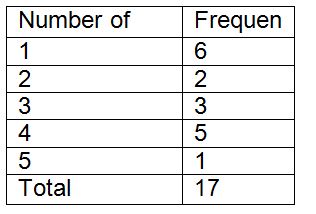What is the difference between a pattern and a theme?
A) ?A theme refers to a consistent way of thinking, feeling, or behaving, while a pattern refers to an idea/point of view shared by several people.
B) ?A theme is unique to the individual and therefore is more difficult to change than a pattern.
C) ?A pattern is unique to the individual and therefore is more difficult to change than a theme.
D) ?A pattern refers to a consistent way of thinking, feeling, or behaving, while a theme refers to an idea/point of view shared by several people.
D
You might also like to view...
Life expectancy is expected to be shorter when one's parents and grandparents died of an illness before age ____.
A. 50 B. 60 C. 70 D. 80
What is the variance?

A. 3
B. 7.5
C. 19
D. 38
Why did Linda strongly urge these men to come together for a face-to?face group? How appropriate was Linda’s urging? When might this encroach upon self-determination?
As an employee of a private, nonprofit HIV/AIDS clinic in a rural North Carolina community, Linda Summerfield’s job was to provide direct services to people with HIV/AIDS as well as to connect them with resources. Aware of their needs, she also respected their need for confidentiality and anonymity in an area where issues surrounding HIV/AIDS were highly charged and prejudice was common. In 1999, Linda was also eager to help six men in her caseload who were struggling with uncertainty, loneliness, and isolation. Aware of their shared needs, she believed in the healing power of group work for such clients. Although initially reluctant, the six men agreed to “meet” via telephone and, despite their apprehension and some technical difficulties, after five weeks all agreed that the experience was helpful. But when meeting via telephone became unworkable, Linda faced decisions over whether and how or where to persuade the men to continue meeting.
A correlation coefficient ______.
A. reveals the strength of the relationship between two variables. B. will provide you with information on the proportion of clients who improved on the target behavior. C. will provide you with information on the means and standard deviations of data for your dependent variable. D. shows whether the study results can be generalized on a scientific basis.